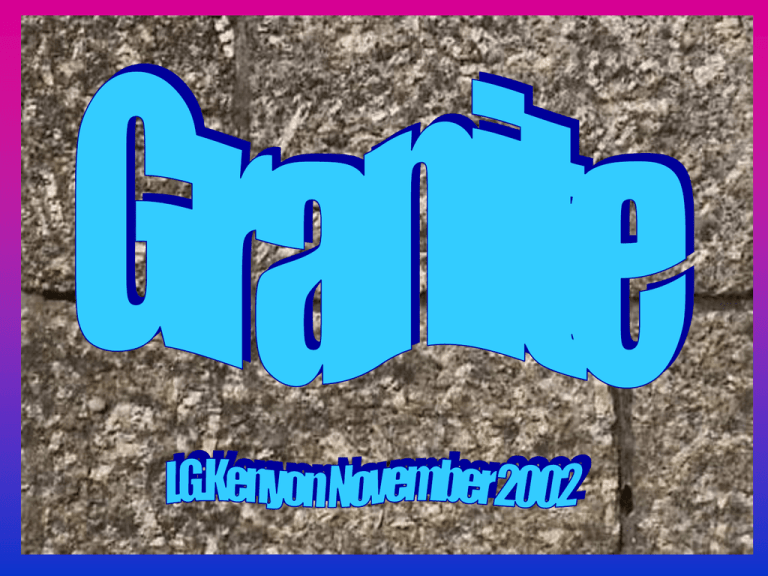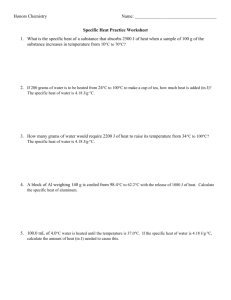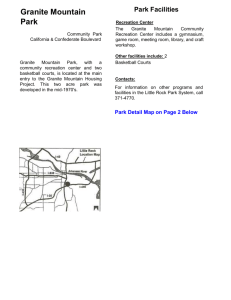Granite
advertisement

Major Granite Outcrops in Devon and Cornwall All the separate outcrops link up at depth to form a huge batholith of granite which comprises many thousand cubic kilometres of rock Lands End 275 – 280 Ma Bodmin Moor 287 – 288 Ma Granites dated at 270 – 300 million years Carn Brea 290 Ma St.Austell Moor 270 – 285 Ma TregonningGodolphin 280 Ma Carnmanellis 290 – 295 Ma Dartmoor 280 - 300 Ma At 6 km depth the granite is still at a temperature of 200°C to 225°C The Process of Granite Emplacement Essential Minerals in Granite • Quartz – colourless, greyish or glassy, shows hexagonal cross section if crystals well formed. Minimum 10% to >60% • Plagioclase Feldspar – white/creamy colour, rectangular shaped crystals • Orthoclase Feldspar – flesh/pink colour, rectangular shaped crystals • Biotite Mica – black in colour, pearly lustre, shows perfect basal cleavage Accessory Minerals in Granite These may make up just 5% of the total rock • Muscovite Mica – silvery/straw colour pearly lustre • Hornblende – greenish-black, prismatic crystals • Iron Pyrite – brassy gold colour, metallic lustre • Tourmaline – greenish black, needle-like crystals Porphyritic Granite Groundmass is much finer grained 1-5mm in diameter Black biotite mica Large feldspar phenocrysts up to 4cm long Well formed euhedral crystals 4cm Colourless or glassy quartz Orthoclase Feldspar phenocrysts show simple twinning Shap Granite or Ademallite Porphyritic texture, large phencrysts up to 3cm surrounded by a finer groundmass 1-3mm in diameter. Produced by a two-stage cooling process Black biotite mica 3cm Simple twinning shown by euhedral orthoclase feldspar crystal Orthoclase feldspar phenocrysts up to 3cm long Colourless, grey or glassy quartz Kaolinised Granite Feldspar phenocrysts decompose to kaolinite (china clay) by hydrolysis Grey/colourless and glassy quartz remains unaltered 4cm Kaolinisation is achieved by hydrolysis and hydrothermal action Kaolinised granite is often referred to as Growan, a mixture of clay minerals and quartz crystals Brown/orange iron oxide staining due to breakdown of biotite mica Tor Formation A tor is an isolated outcrop of jointed granite that rises above a generally flat, plateau-like area. For example Haytor on Dartmoor 454m above sea level The tors represent areas of granite that are relatively more massive than the surrounding granite by having a low concentration of joints. These areas undergo slow rates of denudation (surface lowering) due to the fact water penetration into the rock is limited. Consequently mechanical and chemical weathering proceeds slowly. Areas of high joint concentration undergo relatively rapid disintegration and decomposition and the land surfaces are lowered more rapidly by weathering and erosion. Freeze thaw and hydrolysis are the most important processes in granite weathering. The Effects of Freeze-Thaw Weathering Granite consists of cuboidal or rectangular blocks due to 2 sets of joints intersecting at 90° Car keys for scale Joints widened by freeze-thaw activity Ice occupies 9% more volume than water and can generate immense internal stress in confined spaces Sculptured Granite Blocks Micro-landforms in granite up to 70cm wide x 35cm deep No debris contained within the hollows 30cm Rounded forms suggest hydrolysis followed by wind action to remove any fine material The Effects Of Weathering Surface of granite is crumbly here-a mixture of clay and quartz crystals Joints widened by freeze-thaw activity Car keys for scale Edges of the granite blocks have a rounded form suggesting chemical weathering is important (hydrolysis) The Products of Weathering Tee peg for scale Quartz remains as it not affected by chemical weathering This represents the first stage in the formation of a new sedimentary rock (sandstone) The products such as clay from chemical weathering have been washed or blown way Angular quartz grains ranging in size from 0.5 to 8mm Jointed Granite-Carn Brea Rounded edges suggest chemical weathering by hydrolysis Granite is divided into a series of rectangular or cuboidal blocks by the two sets of joints intersecting at 90 degrees As the overlying sediment (more than 5km) thickness was eroded away, the granite expanded and cracked parallel to its own surface to form near horizontal joints Vertical joints formed as the granite cooled, contracted and solidified Recently fallen block, triggered by freeze-thaw action Granite Tors – Carn Brea Vertical joints formed by cooling and contraction Horizontal joints produced by dilatation or pressure release Granite block or corestone is massive, having no vertical or horizontal joints Logan Stones This large granite boulder weighing many tonnes can be rocked by hand Eventually this block will be pushed away from the tor by freeze-thaw activity Only a small area of the block is in contact with the granite underneath and acts as a pivot Nightjar Rock – A Logan Stone Head Several persons standing on the head causes the stone to rock, even though it weighs many tonnes Wings Beak Very small surface area of block in contact with the underlying granite, this acts as a pivot Clitterblocks around the Tors Solifluction (Soilflow) is responsible for the movement of the granite blocks further downslope mainly between 10,000 and 2 million years ago Large angular clitterblocks of granite up to 2.5m in diameter Freeze-thaw activity is responsible for levering the joint-bounded blocks away from the tors Solifluction Occurs under Periglacial conditions Similar climate to the Canadian Tundra and Siberia today For most of the year the ground is frozen solid During the brief spring/summer, the top part of the soil begins to thaw out, this is the active layer At depth the ground is still frozen and impermeable The active layer is saturated as drainage is impeded The saturated mass of rock fragments and soil can flow down slopes as gentle as just 2 degrees Granite is Impermeable Typical vegetation of granite areas is heather gorse and bracken Granite protrudes through where soil worn away on paths Soil is very thin, just a few centimetres deep Surface water collects in natural hollows after rainfall as granite is impermeable Granite – Country Rock Contact St.Agnes Beacon in the distance, another granite outcrop Killas-metamorphosed mudstones and siltstones Form lower, flatter ground and are used for agriculture Junction between granite and killas de-limited by change in vegetation Granite – bracken and gorse Economic Uses of Granite Granite is used mainly for its bulk physical properties, rather than any minerals it contains The exception is kaolinite (china clay) which is formed by the chemical breakdown of Orthoclase Feldspar It is igneous, comprised of tightly interlocking crystals of quartz, feldspar and mica It is relatively resistant to weathering and erosion It is exposed at the surface in Cornwall and Devon and can be readily quarried The interlocking joint pattern aids the quarrying process Economic uses of Granite Granite intrusions often have tin, copper zinc and lead deposits associated with them Processing plant Conveyor belt from mine South Crofty Tin Mine closed in 1998. It produced 1900 tonnes of tin per year. Average grade of tin ore was 1.4% Mine Head Gear Economic use of Granite The Wellington Hotel, St.Just Granite blockwork Economic uses of Granite Granite Gatepost Penweathers Lane Near Truro Granite sculpture outside Sainsbury’s supermarket, Truro 3m 1m Granite blockwork used for the base Economic uses of Granite Memorial Stone, Truro School Main building, Front Terrace Economic uses of Granite Truro School Chapel Granite doorframes and arch above made of granite Economic uses of Granite Granite wall, Tesco Camborne Granite climbing wall Truro School Sports Hall Economic use of Granite Tomb – St.Just Churchyard Samuels Jewellers, Boscawen Street,Truo Economic uses of Granite Granite mini-roundabout, Tesco Camborne Granite doorstep to butcher’s shop, St.Just Granite at the Golf Club Large granite boulders installed in front of the Pro shop at Perranporth to stop potential ram raiders Granite on the Golf Course Details of the holes are inscribed on large granite blocks with polished front surfaces The 9th Tee Perranporth Golf Club Tee markers are a cylindrical core of granite Granite on the Golf Course Perranporth Golf Club 7th Hole 7th Green Large granite block used to indicate 150m from the front edge of the green Economic uses of Granite Granite planter Village Square, St.Just Granite speed-bumps at Tesco Camborne Economic uses of Granite Carnon Downs Garden Centre Prices range from £30 to £450 Water Feature Garden Seat Birdbath Garden ornaments made of imported Chinese granite Granite Boulders – Carnon Downs Garden Centre Individual boulders retail at £4-50!! Granite boulders approximately 30cm x 30cm for decorative use in the garden Economic uses of Granite Granite chippings sold at garden centres 6mm diameter £2-95 for 25kg at Carnon Downs Garden Centre Economic uses of Granite Granite fenceposts St.Just Churchyard Old granite gravestones laid flat Economic uses of Granite Granite chippings 6mm in diameter used on a patio Free draining, yet acts as a weed suppressant Free draining and rather dry and rough going for snails and slugs! Granite chippings 6mm in diameter used as the flooring in a greenhouse Economic Uses of Granite Penweathers Lane, Near Truro 1m Granite millstone, now used for decorative purpose Economic Uses Of Granite Gravestone, St.Just Churchyard Surface is highly polished Granite chippings 12mm in diameter used for gravel drive Also acts a good weed suppressant Economic use of Granite Sainsbury’s, Truro Granite kerbstones Granite blocks from the former Richard Lander School on this site used to face the Sainsbury’s building Granite wall Economic uses of Granite Front façade of Truro Cathedral Truro Cathedral Spires Economic uses of Granite War memorial Boscawen Street, Truro St.Just Church Clock Tower Economic uses of Granite Granite Cobbles in the road Boscawen Street, Truro Granite used as pavement stone, outside Abbey National, Boscawen Street, Truro Truro City Centre Cathedral Lane – Leats to drain away rain water and wash away any debris 20cm Kerbstones in Boscawen Street Semi-circular channel cut in granite slab to carry water Granite used for building in the CBD of Truro Lloyds/TSB Bank, Boscawen Street,Truro Granite Blocks Truro Library, Pydar Street The whole façade is made of granite blocks The Cheesewring Bodmin Moor Cornwall’s most famous tor and close to Brown Willy, the highest point in Cornwall at 420m high






